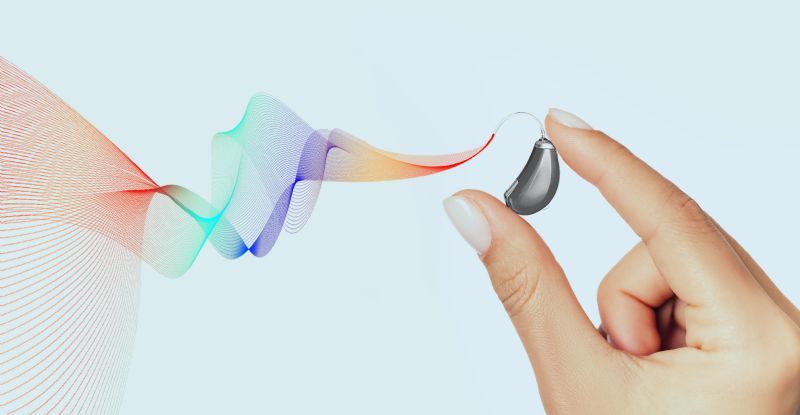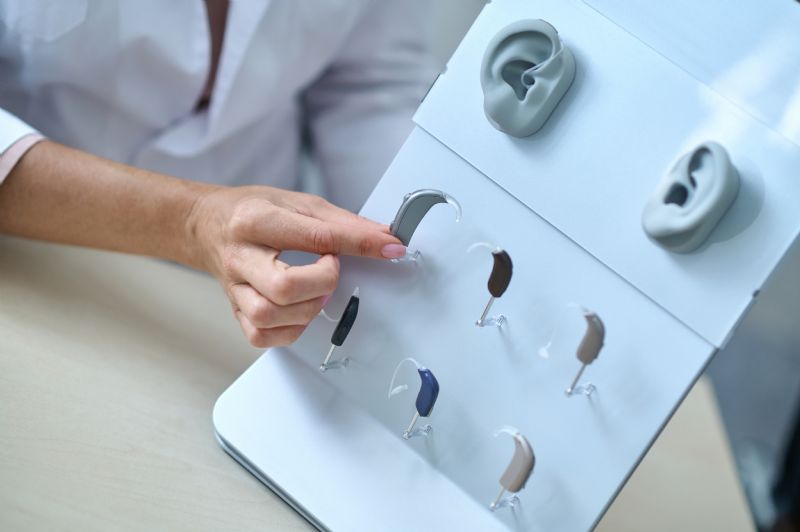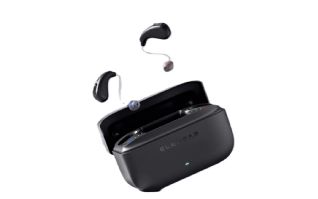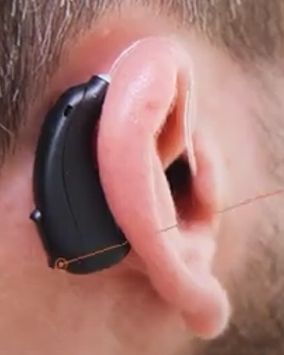 Written by Heather Collins, MSN, RN, CNOR
Written by Heather Collins, MSN, RN, CNOR
Untreated hearing loss can greatly impact the quality of life for many adults in the US, leading to feelings of isolation. Even though hearing loss is linked to serious health conditions such as dementia, depression, low self-esteem, anxiety, reduced mobility, and falls, only 1 in 4 adults who could improve their hearing with hearing aids have ever used them..
If you’ve been waiting to address your own or a loved one’s hearing loss concerns, there has never been a better time to get the hearing aids you’ve been putting off. With many hearing aids now available for sale over the counter (OTC), they have become much more affordable and accessible for adults living with various degrees of hearing loss. Read on to learn more about how hearing aids can optimize your health and well-being.
Designed as a small electronic device that’s worn in or behind the ear, a hearing aid amplifies certain sounds that make it easier for users living with varying degrees of hearing loss to listen, communicate, and participate more fully in daily activities. Powered by regular or rechargeable batteries, hearing aids come in several configurations to accommodate different levels of hearing loss. Useful in both noisy and quiet environments, hearing aids amplify the sounds you want to hear while canceling out unwanted noise.

Hearing aids work by capturing sound waves with a microphone, converting the sound waves into electrical or digital signals, and making them louder with an amplifier, while the receiver or speaker sends the amplified sounds down the ear canal. Although hearing aids do not restore normal hearing, their innovative technology analyzes and adjusts the sound based on an individual’s unique listening needs, degree of hearing loss, and the level of sounds in the environment. Most hearing aids are digital, customizable, and come with automatic features like volume adjustability and pre-programming to improve hearing in a variety of environments.

If you or a loved one are experiencing hearing loss, you now have more options when it comes to choosing a hearing aid. As a new category and historic rule established by the FDA, over-the-counter (OTC) hearing aids are now available since August 2022, making it much more convenient, accessible, and affordable for adults with mild to moderate hearing loss to obtain the hearing assistance they require. Because they don’t require an exam or a prescription, OTC hearing aids can be purchased directly in stores and online, averaging around $1,600, with some single hearing aid options starting as low as $250.
Prescription hearing aids are better suited for users of any age living with severe to profound hearing loss, requiring an in-person exam, prescription, fitting, and other ongoing care. Addressing all levels of hearing loss, prescription hearing aids average around $4,600 per pair.

Whether you’re buying a hearing aid online or going for an in-person visit with a hearing professional, you will need to complete an audiogram to determine how loud sounds need to be for you to hear them. Determining the type, degree, and configuration of hearing loss ensures finding the best hearing aid to fit your unique requirements. Online hearing tests can be done in the comfort and privacy of your home, making it more convenient for people to get tested for hearing loss sooner. Typically, it takes a person an average of 7 to 10 yearsfrom the time they first notice hearing problems to visit an audiologist.
Online hearing tests are demonstrated to be just as accurate as in-person hearing tests and may sometimes be provided free of charge. However, it is recommended by audiology experts to begin with an in-person test, especially if it is the first time taking a hearing test or if the hearing loss is more severe or complex.
Furthermore, Hearing professionals can diagnose the cause of hearing loss by checking for issues such as wax buildup, foreign objects, trauma, diseases, or conditions like tinnitus that can cause hearing loss and affect one's ability to hear in different situations. Visiting an audiologist in person allows for prompt addressing of any problems in addition to providing in-person fitting assistance.

.png)
As the original modern style and most commonly used hearing aid, a behind-the-ear (BTE) hearing aid can accommodate all degrees of hearing loss from mild to profound. Hooking over the top of the ear and resting behind it, a BTE hearing aid has a tube that connects to a custom earpiece called an ear mold that fits in your ear canal. As the most durable type of hearing aid, BTE designs are often used with children as well as adults. They’re less likely to be damaged by earwax or moisture, resulting in fewer repairs and longer life.
A very popular brand of BTE hearing aids is Otofonix!
Although traditionally BTE devices have been the largest type of hearing aid, more recent innovations with mini-BTEs have made them streamlined and barely visible. Yet, they still offer more amplification than other types of hearing aids and have the space for added tech, like directional microphones. While some BTE hearing aids require in-person visits with a hearing professional, many are also available for purchase over the counter.
Most BTE hearing aids are large enough to provide easier handling than CIC devices, although their slightly higher weight may feel too heavy for some users. Older BTE hearing aids may create a plugged sensation as the earmold fills the ear canal, but properly-fitted devices that use a vent can help to minimize this feeling. Newer open-fit hearing aids, also known as thin tube BTEs, sit completely behind the ear, with only a narrow tube inserted into the ear canal, allowing the ear canal to remain open.
 | Elehear Alpha - AI Powered OTC Hearing Aids with Noise Reduction, Feedback Cancellation, and 20 hrs. Battery Life View Product |

Similar to BTE hearing aids, the receiver-in-canal (RIC) and receiver-in-the-ear (RITE) hearing aids use a receiver or speaker that sits inside the ear canal, placing the microphone and amplifier behind the ear. But they’re connected with a tiny wire rather than tubing, resulting in a less visible behind-the-ear portion. Lighter than older BTE hearing aids, RIC and RITE devices are generally more comfortable to wear for long-term applications.
Offering directional microphones and manual control options, RIC and RITE hearing aids also tend to produce less feedback than BTE devices because the microphone is further away from the receiver. Because their design enables the ear canal to remain open, RIC and RITE hearing aids help to prevent the occlusion effect, a plugged-up feeling that is sometimes inherent with other types of hearing aids.
Indicated for mild to severe hearing loss, receiver-in-canal and receiver-in-the-ear hearing aids are more prone to deterioration from moisture and earwax and should be cleaned often for optimal maintenance and longevity. Because they are usually smaller than BTE hearing aids, they might be harder for users living with manual disabilities to manipulate.
.png)
Available in two different styles, in-the-ear (ITE) hearing aids come in a full shell that fills most of the area of your outer ear or a half shell that fills only the lower part. They are seated completely in the outer ear, with all of the parts contained within a plastic case that’s custom-fitted by a hearing professional to conform to your unique ear configuration and size. ITE devices are not available over-the-counter.
Although an ITE hearing aid may pick up more wind noise than smaller CIC devices, it has a larger area to accommodate directional microphones, volume control, Bluetooth, T-coil, and other helpful features that CIC hearing aids may not offer. This capability affords users more control with sound and adjustability to meet their needs.
Indicated for mild to severe hearing loss, in-the-ear hearing aids are larger and more visible than smaller CIC hearing aids, but smaller and less visible than behind-the-ear (BTE) hearing aids. Because the whole device sits inside the ear, ITE hearing aids can be more susceptible to earwax clogging the speaker.
_hearing_aids.jpg)
As one of the most discreet hearing aid types, the in-the-canal (ITC) device is custom-molded to fit partly in the ear canal, making it significantly less visible than larger styles. Popular with users who don’t want others to know they’re wearing a hearing aid, ITC hearing aids are well-suited for mild to moderate hearing loss.
Even though it is smaller in size, an ITC hearing aid often includes tech features that won’t fit on CIC devices, including a directional microphone and Bluetooth. But users living with impairments to their manual dexterity may find it difficult to adjust the features and change the battery because of the ITC's minuscule proportions. In-the-canal devices can be more likely to get clogged by earwax because of their positioning within the ear canal, and may not be the best choice for users with recurring ear infections.
Although most ITC hearing aids are custom-molded to the individual which requires an in-person visit with a hearing professional, there are different sizes available for OTC purchase as well. This type of hearing aid is one of the easiest to use with a phone.
_1.jpg)
A completely-in-canal (CIC) hearing aid is the smallest and least visible of all the hearing aids. Molded to fit inside the ear canal, CIC devices are barely noticeable in the ear, especially the mini CIC and IIC (invisible-in-canal) models. They have a short string for easy removal. With the lightest weight among all hearing aids, CIC hearing aids are exceptionally comfortable to wear for extended periods of time.
Improving mild to moderately-severe degrees of hearing loss, CIC hearing aids do not require custom fitting like some other hearing aid designs. Because they rest completely inside the ear canal, they are not as susceptible to feedback from wind noise. But, their small size can be challenging for some users living with fine-motor impairments, tremors, muscle fatigue, and arthritis to handle, while the smaller battery often has a shorter life than other hearing aids.
With their deep positioning within the ear canal, CIC hearing aids sometimes cause a plugged ear sensation and should be cleaned frequently to prevent wax buildup. CIC hearing aids are available for OTC purchase.
Determining your degree of hearing loss is crucial in finding the right hearing aid to fit your needs. Based on how loud sounds need to be for you to hear them, there are 4 basic levels of hearing loss that include mild, moderate, severe, and profound. The amplification you require in a hearing aid is referred to as unity gain or sound gain. For example, a 60-decibel sound signal amplified to an output of 90 decibels offers a 30-decibel sound gain.
A popular feature that all hearing aid users seem to love, background noise reduction helps you to focus on conversations and other nearby sounds more easily. Limiting noise in the environment you’re in while simultaneously enhancing speech reception, all hearing aids offer some level of noise reduction, along with wind noise reduction.
Although some hearing aids can only focus the microphone in one direction, directional microphones are specially placed to enable users to hear sounds coming from the front, with some reduction of sounds coming from beside or behind the user. They improve the ability to hear and focus on conversations when users are in an environment with a lot of background noise.
In today’s high-tech world, it’s no surprise that more and more hearing aids are interfacing wirelessly with Bluetooth-compatible devices. Built into most smartphones, TVs, and tablets, Bluetooth options on hearing aids enable you to stream the sound from these devices directly to your hearing aids. You can conveniently adjust the volume on your hearing aids while others can keep the TV volume at a lower level. Otofonix GROOVE Hearing Aids with Bluetooth is a great choice.
Innovative hearing aid technology has also made it possible to use your smartphone to adjust the volume and listening profiles on your hearing aids without having to touch them! If you’re comfortable with technology and enjoy using apps on your phone, smartphone hearing aid apps offer a wide range of functionality, including connecting directly with an audiologist and configuring preset sound profiles for a variety of environments.
Having a good hearing aid warranty is an important factor in determining the best hearing aids to meet your needs. While most companies provide a warranty of 1 to 3 years from the date of purchase, it’s crucial to understand what is and isn’t included. On average, most people wear their hearing aids for 5 years before replacing them, so finding hearing aids with an extended warranty is typically your best option. Whether they’re OTC or prescription, hearing aids are an investment you want to protect.
Making it easier to hear when talking on the phone, telecoils reduce the sound from the environment while simultaneously picking up the sounds from the phone. Also known as a T-coil, telecoils also allow you to use your hearing aid with other devices or at facilities that are equipped with specialized assistive technology called a hearing loop, or public induction loop system, enhancing your ability to hear.
Often included on cochlear implants, direct audio input (DAI) is also offered on many hearing aids, enabling users to plug into audio from a computer, music device, or TV with a cord. Bypassing the microphone, DAI directly connects MP3 players, phones, and assistive listening devices to your hearing aids, offering a better quality audio signal that’s less susceptible to interference.
Some hearing aids can store several pre-programmed settings to better suit different listening needs and changing environments. Quick and easy to apply, programs can include a setting for a quiet home environment or a loud, busy restaurant, making it easier to move and hear through your changing world.
If you need hearing aids in both ears, binaural signal processing conveniently allows them to be programmed to function together. Synchronization allows adjustments like volume control and pre-programming applied to one hearing aid to be made on the other aid, resulting in simpler control.
While most contemporary hearing aids offer some level of water resistance, these electronic devices are not waterproof and can be damaged by moisture over time. Hearing experts recommend removing your hearing aids before showering/bathing, swimming, using a sauna, spraying your hair with hairspray or other products, working/exercising outside in hot weather, and going to bed.
Hearing aids help people to hear and communicate more clearly and come in several different styles to suit various degrees of hearing loss. They’re much more accessible and affordable since the FDA established its historic rule in August 2022, allowing many hearing aids to be sold directly to consumers over-the-counter (OTC).
This guide covers all the important information you need to know to select the best hearing aid for yourself or a loved one. It includes information on the different types of hearing aids, useful features to consider, and other relevant facts about prescription and over-the-counter (OTC) hearing aids.
Thank you for investing your time to learn about this recent advancement in the hearing aid community. We invite you to explore our expanding collection of educational and informative resources at Caregiver University.

Heather Collins, MSN, RN, CNOR
Heather is a registered nurse and freelance health writer with a Master's degree and over 24 years of nursing and leadership experience. Heather cares for patients of all ages in various healthcare settings, including inpatient acute care nursing, GI procedural nursing, cardiac lab, infertility clinics, pediatrics, and surgical services. Heather is dedicated to providing high-quality care and sharing reliable, evidence-based information that empowers people to make informed decisions about their and their loved ones' health.
